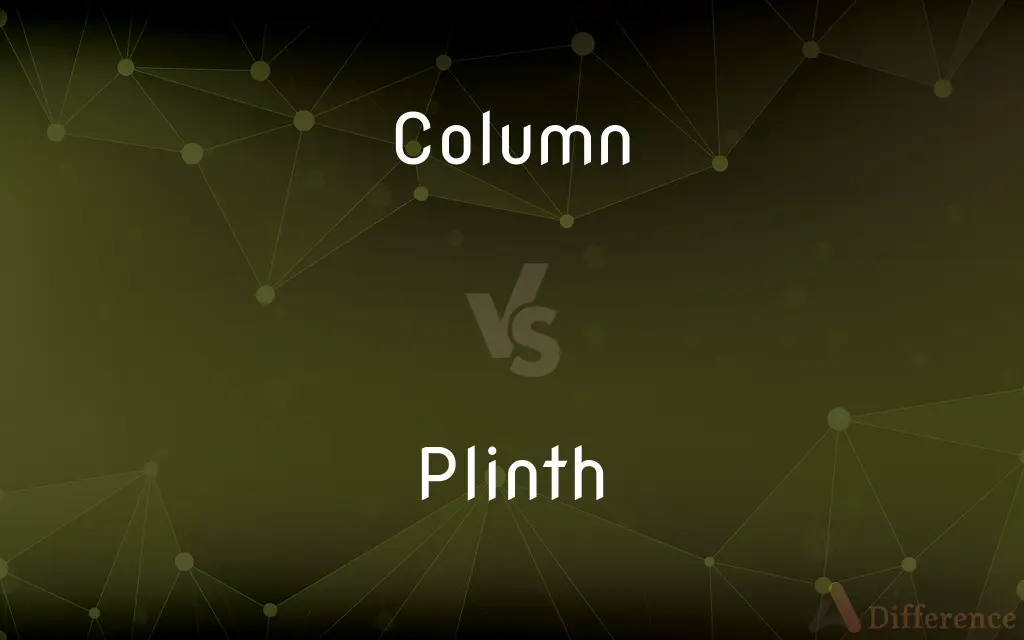Column vs. Plinth — What's the Difference?

Difference Between Column and Plinth
ADVERTISEMENT
Compare with Definitions
Column
A column or pillar in architecture and structural engineering is a structural element that transmits, through compression, the weight of the structure above to other structural elements below. In other words, a column is a compression member.
Plinth
A block or slab on which a pedestal, column, or statue is placed.
Column
A vertical structure usually consisting of a base, a cylindrical shaft, and a capital, used as a support or standing alone as a monument.
Plinth
The base block at the intersection of the baseboard and the vertical trim around an opening.
Column
Any slender vertical support, as of steel or reinforced concrete.
ADVERTISEMENT
Plinth
A continuous course of stones supporting a wall. Also called plinth course.
Column
Something resembling an architectural column in form or function
A column of mercury in a thermometer.
Plinth
A square base, as for a vase.
Column
One of two or more vertical sections of text lying side by side in a document and separated by a rule or a blank space.
Plinth
A block or slab upon which a column, pedestal, statue or other structure is based.
Column
An arrangement of numbers in a single vertical line.
Plinth
The bottom course of stones or bricks supporting a wall.
Column
A feature article that appears regularly in a publication, such as a newspaper.
Plinth
A base or pedestal beneath a cabinet.
Column
A formation, as of troops or vehicles, in which all elements follow one behind the other.
Plinth
In classical architecture, a vertically faced member immediately below the circular base of a column; also, the lowest member of a pedestal; hence, in general, the lowest member of a base; a sub-base; a block upon which the moldings of an architrave or trim are stopped at the bottom. See Illust. of Column.
Column
(Botany)A columnlike structure, especially one formed by the union of a stamen and the style in an orchid flower, or one formed by the united staminal filaments in flowers such as those of the hibiscus or mallow.
Plinth
An architectural support or base (as for a column or statue)
Column
(Anatomy)Any of various tubular or pillarlike supporting structures in the body, each generally having a single tissue origin and function
The vertebral column.
Column
(architecture) A solid upright structure designed usually to support a larger structure above it, such as a roof or horizontal beam, but sometimes for decoration.
Column
A vertical line of entries in a table, usually read from top to bottom.
Column
A body of troops or army vehicles, usually strung out along a road.
Column
A body of text meant to be read line by line, especially in printed material that has multiple adjacent such on a single page.
It was too hard to read the text across the whole page, so I split it into two columns.
Column
A unit of width, especially of advertisements, in a periodical, equivalent to the width of a usual column of text.
Each column inch costs $300 a week; this ad is four columns by three inches, so will run $3600 a week.
Column
(by extension) A recurring feature in a periodical, especially an opinion piece, especially by a single author or small rotating group of authors, or on a single theme.
His initial foray into print media was as the author of a weekly column in his elementary-school newspaper.
Column
Something having similar vertical form or structure to the things mentioned above, such as a spinal column.
Column
(botany) The gynostemium
Column
(chemistry) An object used to separate the different components of a liquid or to purify chemical compounds.
Column
A kind of pillar; a cylindrical or polygonal support for a roof, ceiling, statue, etc., somewhat ornamented, and usually composed of base, shaft, and capital. See Order.
Column
Anything resembling, in form or position, a column in architecture; an upright body or mass; a shaft or obelisk; as, a column of air, of water, of mercury, etc.; the Column Vendôme; the spinal column.
Column
A body of troops formed in ranks, one behind the other; - contradistinguished from line. Compare Ploy, and Deploy.
Column
A number of ships so arranged as to follow one another in single or double file or in squadrons; - in distinction from "line", where they are side by side.
Column
A perpendicular set of lines, not extending across the page, and separated from other matter by a rule or blank space; as, a column in a newspaper.
Column
A perpendicular line of figures.
Column
The body formed by the union of the stamens in the Mallow family, or of the stamens and pistil in the orchids.
Column
One of a series of articles written in a periodical, usually under the same title and at regular intervals; it may be written and signed by one or more authors, or may appear pseudonymously or anonymously, as an editorial column.
Column
A line of (usually military) units following one after another
Column
A vertical glass tube used in column chromatography; a mixture is poured in the top and washed through a stationary substance where components of the mixture are adsorbed selectively to form colored bands
Column
A linear array of numbers one above another
Column
Anything tall and thin approximating the shape of a column or tower;
The test tube held a column of white powder
A tower of dust rose above the horizon
A thin pillar of smoke betrayed their campsite
Column
An article giving opinions or perspectives
Column
A vertical structure standing alone and not supporting anything (as a monument or a column of air)
Column
(architeture) a tall cylindrical vertical upright and used to support a structure
Share Your Discovery

Previous Comparison
SGML vs. HTML
Next Comparison
Diminishment vs. Diminution














































